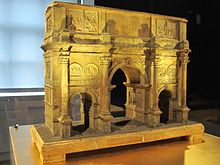Cork model
A cork model is a predominantly of cork manufactured architectural model . The art of cork making is also known as phelloplastic ( Greek φελλός phellos , German 'cork' ).
Christmas cribs made of cork , which have been made in Naples since the 16th century, can be regarded as forerunners . The invention of the construction of architectural models from cork was attributed to Augusto Rosa in Rome, but Giovanni Altieri (documented 1766 / 67–1790) and Antonio Chichi (1743–1816) were already active as manufacturers of cork models in Rome. The Chichi models were copied with great success by Carl May (1747–1822, Erfurt and Aschaffenburg). Other cork models from the 19th century are known from Luigi Carotti (Rome), Carlo Lucangeli (1747–1812, Rome, Naples), Domenico, Agostino and Felice Padiglione (Naples) and Auguste Pelet (1785–1865, Nîmes). A contemporary phelloplastic artist is Dieter Cöllen .
The word Phelloplastik was formed by Karl August Böttiger , as he himself reports in a comment on the article Ueber Herr Mey's Felloplastik by Jakob Dominikus in Der Neue Teutsche Merkur : One is given this newly created word, but formed according to the analogy of ὰνδριαντοπλαςικὴ, κηροὴπ usαw I am happy to forgive you if you got to know the ingenious artist, who deserves far more general support, from this interesting piece of news. The Greeks called the cork oak and its products Φελλος. So Felloplastik is called Bildnerey in cork.
Mostly antique buildings were depicted, as cork is particularly well suited to reproducing the characteristic weathered wall surfaces. As a rule, they were produced on a large scale and with great precision, often with an archaeological claim. They were highly valued at the royal courts of the 18th century, and although (or because) only a few hundred pieces were produced because of the high cost, they were represented at all important royal courts. Since they were often transferred to the then newly founded model collections and architecture schools in the late 18th and early 19th centuries, they played a major role in the communication of ancient architecture in the countries north of the Alps. Despite their fragility, they have often survived better than wooden models that are threatened by wood-destroying insects.
Collections
Important collections of Antonio Chichi's cork models can be found in the Art Academy in St. Petersburg (34 preserved copies, made around 1774), in Wilhelmshöhe Palace in Kassel (33 models preserved, made 1777–1782), the Hessian State Museum Darmstadt (26 models preserved, Acquired in 1790/91) and the Ducal Museum Gotha (12 models, acquired after 1777/78).
The largest collection of cork models by Carl May with 54 pieces (after war losses) is in Aschaffenburg ( Johannisburg Castle ). Another large collection of his models was created in Mecklenburg . Today it is part of the collection of the State Museum Schwerin and is shown in Ludwigslust Palace .
Another collection of cork models from different manufacturers is in Sir John Soane's Museum in London.
Modern cork models of antique buildings by Dieter Cöllen are exhibited in the Praetorium in Cologne.
literature
- Gabriel Christoph Benjamin Busch : Handbook of Inventions Vol. 10, 1817, pp. 236-238 Lemma Phelloplastik .
- Erich Stenger : Phelloplastik, the small art of cork making . Charlottenburg 1927.
- Wasmuth's Lexicon of Architecture . Vol. 4, Berlin 1932, Lemma Phelloplastik
- Eugen von Philippovich: Curiosities - Antiques. A guide for collectors and enthusiasts . Braunschweig 1966, pp. 489-494.
- Valentin Kockel : Carrying Rome over the Alps. Cork models of ancient architecture in the 18th and 19th centuries . In: Werner Helmberger, Valentin Kockel (ed.): Carrying Rome over the Alps. Princes collect ancient architecture. The Aschaffenburg cork models . Landshut / Ergolding 1993, ISBN 3-9802205-9-1 , pp. 11–31.
- Françoise Lecocq: Les premières maquettes de Rome. L'exemple des modèles réduits en liège de Carl et Georg May dans les collections européennes aux XVIIIe-XIXe siècles. In: Philippe Fleury, Olivier Desbordes (ed.): Roma illustrata. Representations de la ville . Caen 2008, ISBN 978-2-84133-310-3 , pp. 227-260 (overview of all known cork sculptors and collections of cork models, digitized version ).
- Valentin Kockel: False Friends - faux amis? Piranesi's vedute and the cork models . In: Dietrich Boschung (ed.): Archeology as art. Archaeological objects and processes in the visual arts of the 18th century and the present . Paderborn 2015, ISBN 978-3-7705-5950-3 , pp 13-38 ( Teildigitalisat ).
Remarks
- ^ Franz Oberthür : About the inventor of the Phelloplastik . In: Journal des Luxus und der Moden 20, 1805, pp. 288–290 ( digitized version ); During his stay in Rome, Oberthür lived in Augusto Rosa's house.
- ↑ Nina Zimmermann-Elseify: Cork models of the present. Models of antique buildings by Dieter Cöllen . In: Ancient Buildings. Cork models by Antonio Chichi 1777–1782. Catalog edited by Peter Gercke and Nina Zimmermann-Elseify (= catalogs of the Staatliche Museen Kassel 26). Kassel 2001, pp. 45-55; Website Atelier Dieter Cöllen .
- ↑ Vol. 1800, Part I, pp. 325–336, here p. 325 ( digitized version ); Reprinted in: Werner Helmberger, Valentin Kockel (Ed.): Carrying Rome over the Alps . Arcos, Landshut / Ergolding 1993, p. 85.
- ↑ Irina Tatarinova: Architectural models at the St Petersburg Academy of Fine Art . In: Journal of the history of collections 18, 2006, pp. 27-39.
- ↑ Uta Wallenstein: Duke Ernst II as a collector of antiquities. The collection of antique cork models by Antonio Chichi (1743–1816) . In: The Gotha residence at the time of Duke Ernst II of Saxe-Gotha-Altenburg (1772–1804) . Gotha 2004, pp. 229-244.
- ↑ Cork models in the Praetorium . City Cologne. Retrieved March 5, 2014.
